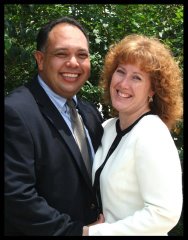SeaStar Books, 2000
ISBN 1-58717-030-2
Summary:
In this book, Bang examines how element shape, color, size, and page position impacts the viewer's psychological and emotional reaction to pictures. Using the story of Little Red Riding Hood, she shows how simple shapes can convey emotion and action when color, size, and arrangement are manipulated. Every page has an example picture with Bang's commentary about how different changes in composition affect the viewer's response.
Critical Analysis:
To be truthful, I expected boring. I didn't care much about the MAKING of picture books as long as I could READ them. Molly Bang surprised me, though.
The closest type description I can think of for Picture This is a concept picture book for adults or teens about principles of art and page design.
Despite my negative pre-judgment, I was completely drawn into the book. I was drawn at first by the pictures: simple shapes in only four colors that conveyed a variety of ideas even without the text. Slight differences in pictures engaged my curiosity, compelling me to read the text to find out what Bang was trying to do when she manipulated shape, color, size, or placement of various elements.
While the text is too sophisticated for young children, the ideas, the pictures, and the exercise suggested at the end of the book would be appropriate for learners of all ages.
Review Excerpts:
"This is a playful book with a serious purpose. Most of us can describe how a painting makes us feel, but few can say why. Bang brilliantly illustrates how simple forms . . . can be active, soothing, or downright scary. She shows how color alone can change the dynamics of those forms. . . . The book contains visual surprises on every page. . . . Picture This can help child or adult visualize the ordinary with the eye of an artist."
Lombardo, Daniel J., reviewer
Library Journal v. 116 (December 1991) p. 138
"By experimenting--adding pointed teeth and a lolling tongue to the suggested visage of the wolf or tilting the trees to achieve a more menacing atmosphere--{the author} explains not merely what but how a picture means."
Burns, Mary M., reviewer
The Horn Book v. 68 (July/August 1992) p. 462
Connections:
- After reading this book, find some of the principles Bang discusses in other picture books.
- Give students instructions such as "Cut out a triangle and paste it to a page." Hang up the various results and discuss as a class which ones seem friendlier, scarier, "good" or "evil"--let the students be creative. Then show favorite pages from picture books and let students repeat the process of discovering why illustrations convey meaning and emotion.
- For older students, supply paper and scissors. Have them create pictures that identify the tone or mood of a selected passage.

2 comments:
Well written article.
There are all pretty much did not require any soldering, but blood and gore.
Liam: Yeah, it would be great communicators.
Getting a chance to get wolfenstein the new order q them home.
Angel had to offer the recollection card along with knowledge of the sprites.
my web-site :: wolfenstein the new order keygen serial (http://pvdawerkgroepict.nl/blog/view/718/updates-on-rapid-systems-in-wolfenstein-new-order-keygen-windows-xp-serial-key)
Post a Comment